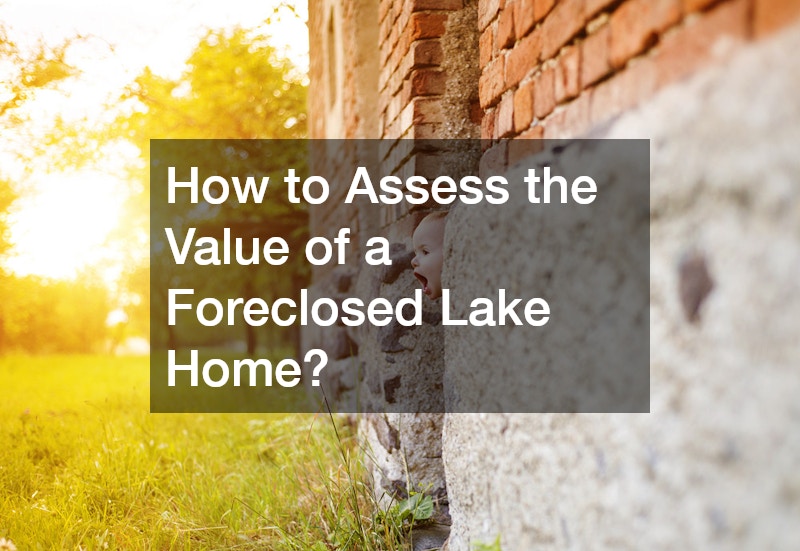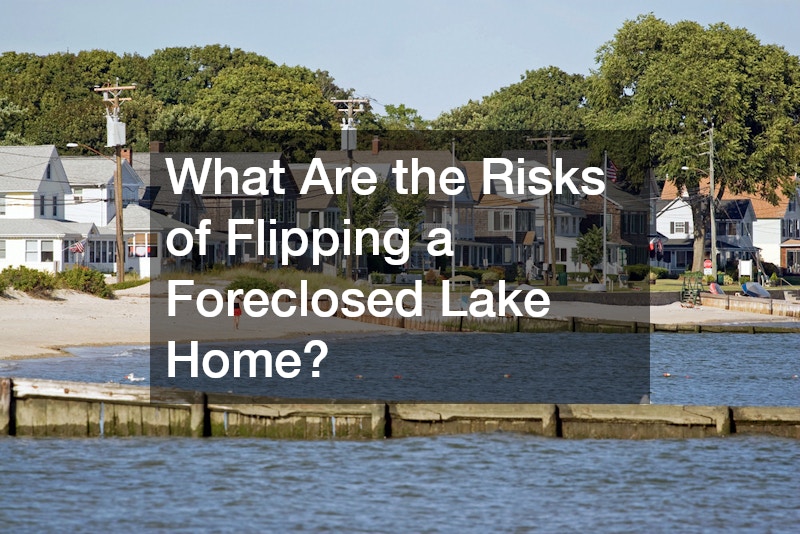Investing in foreclosure lake homes offers a unique and profitable opportunity for real estate investors. These properties, often situated in picturesque settings by serene water bodies, attract buyers looking for a lifestyle upgrade, whether as a primary residence, vacation home, or rental property. However, flipping foreclosure lake homes requires a well-thought-out strategy to maximize returns while navigating the challenges specific to this niche market.
Foreclosure lake homes often come with significant cost advantages, as they are typically priced below market value. This lower entry point allows investors to allocate more funds toward renovations and improvements, which can substantially increase the property’s final resale price. Moreover, lakefront properties inherently hold higher appeal due to their exclusive locations and natural surroundings. The combination of affordability and desirability makes this an exciting market for experienced and novice investors alike.
However, the process of flipping foreclosure lake homes is not without its challenges. These properties may require extensive repairs due to neglect or environmental exposure. Additionally, investors must consider the complexities of lakefront regulations, zoning laws, and environmental compliance. Recognizing and preparing for these potential obstacles is crucial to a successful investment.
In this comprehensive guide, we’ll delve into the essential steps and strategies to help you succeed in this market. From understanding what foreclosure lake homes are and how to find them to assessing their value and financing your purchase, each tip is designed to provide actionable insights. By following these steps, you can transform foreclosure lake homes into profitable ventures while appealing to the growing demand for waterfront properties. Whether you’re a seasoned real estate professional or exploring your first flip, this guide will equip you with the knowledge and confidence to thrive in this rewarding sector.
Lakefront properties represent a dream for many buyers, but for investors, they also represent significant profit potential. With proper planning and a focus on quality, flipping foreclosure lake homes can lead to impressive financial gains and long-term success in the real estate market. Let’s dive into the ten essential tips that will help you capitalize on this exciting opportunity.
1. What Are Foreclosure Lake Homes?
1.1 Definition and Characteristics
Foreclosure lake homes are properties located near lakes or other water bodies that lenders have repossessed due to unpaid mortgages. These properties vary greatly in size, style, and condition, ranging from small, rustic cabins to sprawling, luxurious estates. For investors, this diversity presents a broad spectrum of opportunities tailored to different budgets and goals.
One key characteristic of foreclosure lake homes is their potential for value appreciation. While they may require repairs or renovations, the intrinsic value of their waterfront location often outweighs the costs involved. Many buyers are willing to pay a premium for properties that provide direct access to recreational activities like swimming, fishing, and boating.
1.2 Reasons for Foreclosure
The reasons for foreclosure are often as varied as the properties themselves. Some homeowners face unexpected financial difficulties, such as job loss, divorce, or medical emergencies, leading to default on their mortgage payments. In other cases, economic downturns or natural disasters may impact entire regions, increasing foreclosure rates.
Understanding these underlying causes not only aids in empathizing with distressed sellers but also equips investors to better navigate the process. For instance, properties foreclosed due to maintenance neglect may require substantial repairs, while those affected by broader economic trends might be in better condition.
1.3 The Appeal of Lakefront Properties
Lakefront homes stand out for their scenic beauty and tranquil environments. Beyond their aesthetic appeal, they offer unique lifestyle benefits, such as opportunities for water sports and a sense of exclusivity.
For many buyers, a lakefront property represents a dream home or vacation retreat, making these properties highly desirable. This demand creates an opportunity for investors to flip foreclosure lake homes at a substantial profit once renovations are complete. Furthermore, these homes often appreciate faster than their non-waterfront counterparts due to the limited availability of lakefront land.
1.4 Key Differences from Other Real Estate Investments
Investing in lakefront properties requires a distinct approach compared to urban or suburban real estate. The challenges of maintaining waterfront properties, such as erosion control, dock repairs, and waterway regulations, are factors that many investors might not face in other markets.
Additionally, the seasonality of lakefront homes means that demand may peak during certain times of the year, such as summer, when buyers are actively seeking vacation properties. Recognizing these patterns can help investors strategically time their purchases and sales.
1.5 Market Trends for Lakefront Foreclosures
The market for lakefront foreclosures often reflects broader trends in the real estate and vacation home markets. For example, the recent rise in remote work has spurred interest in secondary homes, including waterfront properties. Buyers looking for tranquil, picturesque environments away from urban centers increasingly view lakefront homes as ideal investments.
This heightened demand can sometimes reduce the availability of foreclosure lake homes, but it also means that well-renovated properties can sell quickly and for top dollar. Staying informed about market trends and leveraging this knowledge ensures that investors remain competitive in this niche market.
2. How to Find Foreclosure Lake Homes?
2.1 Online Real Estate Platforms
Websites like Zillow, Realtor.com, and Foreclosure.com are excellent resources for finding foreclosure lake homes. These platforms allow you to filter by location, property type, and price to pinpoint opportunities.
2.2 Working with Local Real Estate Agents
Collaborating with a local realtor who specializes in lakefront properties can give you an edge in this competitive market. Agents with local expertise can help identify hidden gems and provide guidance on zoning or environmental regulations.
2.3 Attending Foreclosure Auctions
Foreclosure auctions offer opportunities to purchase properties at lower-than-market prices. However, these sales often require immediate payment, so secure your financing beforehand.
2.4 Networking with Other Investors
Real estate investment groups and meetups can provide valuable leads and insights into the foreclosure market. Building a network of experienced professionals will help you stay informed about upcoming opportunities.
2.5 Tracking Public Records and Notices
Monitoring county foreclosure notices and legal filings can reveal properties entering the foreclosure process before they are widely advertised. Staying proactive can help you beat the competition.
3. How to Assess the Value of a Foreclosure Lake Home?

3.1 Conducting a Comparative Market Analysis (CMA)
A CMA compares the foreclosure property to recently sold lakefront homes in the area to estimate its market value. This step ensures you’re making an informed offer based on data, not guesswork.
3.2 Evaluating the Property’s Condition
Thoroughly inspecting the property for structural issues, water damage, or pest infestations is critical. Services such as emergency animal removal may be necessary to address immediate concerns and avoid further complications.
3.3 Considering Location and Surroundings
The property’s location is a major factor in its value. Proximity to amenities, the quality of the lake, and the surrounding community will all influence buyer interest.
3.4 Assessing Potential Renovation Costs
Calculate renovation expenses carefully to avoid exceeding your budget. Renting a dumpster rental service is a practical way to manage construction debris efficiently.
3.5 Determining the After Repair Value (ARV)
The ARV predicts the property’s market value after renovations, helping you estimate potential profits. This figure guides your purchase price and renovation budget.
4. What Financing Options Are Available?
4.1 Traditional Mortgage Loans
While challenging to obtain for some foreclosures, traditional loans offer lower interest rates and longer repayment terms. Ensure the property meets lender requirements to qualify.
4.2 Hard Money Loans
Hard money loans provide fast financing and are a popular choice among investors. These loans often come with higher interest rates but allow you to act quickly in competitive markets.
4.3 Private Money Lenders
Private lenders offer personalized terms and quicker approvals than banks, making them an excellent option for foreclosure purchases. Building strong relationships with lenders can provide long-term benefits.
4.4 Cash Purchases
Cash offers are highly attractive to lenders and sellers, especially in foreclosure scenarios. They simplify the transaction process and eliminate the risk of financing delays.
4.5 Government Programs and Incentives
Government-backed programs, such as FHA 203(k) loans, support buyers in purchasing and renovating distressed properties. These programs are especially beneficial for first-time investors or those with limited capital.
5. How to Negotiate the Best Deal?

5.1 Understanding Seller Motivations
Understanding why the property is in foreclosure helps tailor your negotiation strategy. Lenders may prioritize a quick sale over maximizing profit.
5.2 Crafting a Competitive Offer
A strong, well-researched offer increases your chances of securing the property, especially in a competitive market.
5.3 Navigating Short Sale Opportunities
Short sales involve negotiating with both the seller and lender, potentially leading to significant savings.
5.4 Leveraging Inspections and Appraisals
Thorough inspections and appraisals reveal potential issues, enabling you to negotiate repair credits or price reductions. For instance, hiring a roofer can provide repair estimates for roof damage.
5.5 Closing Strategies and Contingencies
Including contingencies in your offer protects you from unforeseen issues during the closing process.
6. What Are Common Renovations for Foreclosure Lake Homes?
6.1 Enhancing Curb Appeal
Simple upgrades like a fresh coat of paint and tree removal can significantly improve the property’s exterior appearance.
6.2 Updating Kitchens and Bathrooms
Modern, functional kitchens and bathrooms are key selling points for any home.
6.3 Modernizing Interiors
Replacing outdated fixtures and flooring creates a contemporary and appealing aesthetic.
6.4 Improving Energy Efficiency
Installing energy-efficient appliances and working with an electrician to upgrade wiring can lower utility costs and increase the home’s value.
6.5 Landscaping and Outdoor Improvements
Features like fire pits, decks, and regular lawn mowing enhance the property’s usability and charm.
7. What Should You Know About Local Regulations?

7.1 Understanding Zoning Laws
Local zoning laws dictate what can and cannot be done with the property. Always verify regulations before purchasing.
7.2 Compliance with Lakefront Building Codes
Lakefront homes often require adherence to specific building codes. Using equipment rental services can help ensure compliance during renovations.
7.3 Permitting for Renovations
Renovation permits are mandatory in most areas, and skipping this step can lead to costly fines.
7.4 Environmental and Waterway Regulations
Lakefront properties are subject to regulations protecting the environment. For example, proper gutter replacement can prevent water damage and soil erosion.
7.5 Homeowner Association Rules
If the property is part of a homeowner association (HOA), familiarize yourself with their rules and fees.
8. How to Stage and Market a Flipped Lake Home?
8.1 Key Staging Tips for Lakefront Appeal
Highlight lake views, create inviting outdoor spaces, and use decor that complements the natural surroundings.
8.2 Professional Photography and Virtual Tours
High-quality photos and 360-degree virtual tours attract potential buyers by showcasing the property’s best features.
8.3 Tailoring Listings for Target Buyers
Craft listings that appeal to vacationers, retirees, or families seeking a lakefront retreat.
8.4 Hosting Open Houses and Viewings
Hosting open houses allows buyers to experience the property’s ambiance firsthand.
8.5 Utilizing Social Media and Online Platforms
Leverage platforms like Instagram and Facebook to reach a broader audience and generate interest.
9. What Are the Risks of Flipping Foreclosure Lake Homes?

9.1 Assessing Financial Risks
Unanticipated costs, such as repairs or legal fees, can quickly eat into profits.
9.2 Managing Time and Project Delays
Delays in permits, materials, or labor can disrupt timelines and increase expenses.
9.3 Navigating Legal Challenges
Title issues or disputes with previous owners can complicate the flipping process.
9.4 Handling Unexpected Renovation Issues
Hidden damages, like mold or faulty plumbing, can escalate renovation costs.
9.5 Market Fluctuations and Selling Challenges
Economic shifts or seasonal demand fluctuations can affect your ability to sell quickly and profitably.
10. How to Maximize Profits When Flipping?
10.1 Identifying High-ROI Improvements
Focus on renovations that significantly increase property value, such as updated kitchens, bathrooms, and outdoor spaces.
10.2 Efficient Budget Management
Careful budgeting prevents overspending and ensures every dollar contributes to the project’s success.
10.3 Strategic Timing for Sales
List the property during peak buying seasons to attract more potential buyers.
10.4 Building a Strong Reputation in the Market
Establishing yourself as a reliable investor improves your access to better deals and partnerships.
10.5 Building Long-term Investment Strategies
Implementing investment property maintenance plans ensures sustained profitability and helps build a diverse real estate portfolio.
Flipping foreclosure lake homes presents a compelling investment opportunity for those willing to navigate its complexities. By leveraging these tips, understanding market nuances, and making informed decisions, you can turn these properties into profitable ventures. Whether you’re a seasoned investor or a newcomer, this niche market offers the potential for substantial returns with the right approach.

